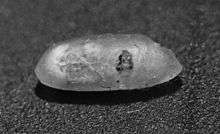Rice weevil
| Rice weevil | |
|---|---|
 | |
| Scientific classification | |
| Kingdom: | Animalia |
| Phylum: | Arthropoda |
| Class: | Insecta |
| Order: | Coleoptera |
| Family: | Curculionidae |
| Subfamily: | Dryophthorinae |
| Genus: | Sitophilus |
| Species: | S. oryzae |
| Binomial name | |
| Sitophilus oryzae (Linnaeus, 1763) [1] | |
The rice weevil (Sitophilus oryzae) is a stored product pest which attacks several crops, including wheat, rice, and maize.
Description
The adults are around 2 mm long with a long snout. The body color appears to be brown/black, but on close examination, four orange/red spots are arranged in a cross on the wing covers. It is easily confused with the similar looking maize weevil, but there are several distinguishing features:[2]
| Rice weevil (S. oryzae) | Maize weevil (S. zeamais) family : |
|---|---|
.jpg) | |
 | |
| Longitudinally elliptical punctures on pronotal dorsum | Circular punctures on pronotal dorsum |
| Pronotal punctures are separated by a flat, median, longitudinal puncture-free zone | Pronotal punctures have no median puncture-free area and are nearly equally spaced apart |
| Less than 20 pronotal punctures along the approximate midline, running from neck to scutellum | More than 20 pronotal punctures along the approximate midline, running from neck to scutellum |
| Scutellar elevations relatively closer together compare to their longitudinal length | Scutellar elevations relatively farther apart compared to their longitudinal length |
| Scutellar elevations extend longitudinally approximately more than halfway down the scutellum | Scutellar elevations extend longitudinally approximately halfway down the scutellum |
| Proepimera meets behind the fore coxae and along the posterior edge, has a distinct curved notch | Proepimera meets behind the fore coxae and has a barely discernible notch along the posterior edge at the site of the meeting
point |
| Aedeagus (in males) is smooth and shiny on the dorsal surface | Aedeagus has two dorsal, longitudinal grooves |
Biology
Adult rice weevils are able to fly,[3] and can survive for up to two years. Females lay 2-6 eggs per day and up to 300 over their lifetime. The female uses strong mandibles to chew a hole into a grain kernel after which she deposits a single egg within the hole, sealing it with secretions from her ovipositor. The larva develops within the grain, hollowing it out while feeding. It then pupates within the grain kernel and emerges 2–4 days after eclosion.

Male S. orzyae produce an aggregation pheromone ((4S,5R)-5-Hydroxy-4-methylheptan-3-one) to which males and females are drawn. A synthetic version is available which attracts rice weevils, maize weevils and grain weevils. Females produce a pheromone which attracts only males.
Control
Control of weevils involves locating and removing all potentially infected food sources. Rice weevils in all stages of development can be killed by freezing infected food below -17.7 °C (0 °F) for a period of three days, or heating to 60 °C (140 °F) for a period of 15 minutes.[4]
See also
- Granary weevil (Sitophilus granarius)
- Maize weevil (Sitophilus zeamais)
References
- ↑ "Sitophilus oryzae". Integrated Taxonomic Information System.
- ↑
- ↑ http://edis.ifas.ufl.edu/ig120
- ↑ "Rice Weevil and Granary Weevil | Iowa Insect Information Notes". Ipm.iastate.edu. 2005-07-29. Retrieved 2013-10-05.